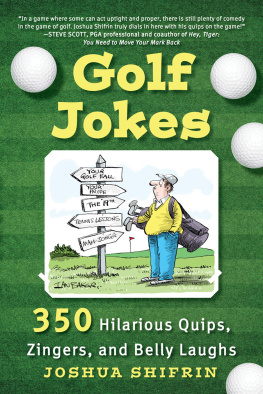2015 by Quirk Productions, Inc.
All rights reserved. No part of this book may be reproduced in any form without written permission from the publisher.
Library of Congress Cataloging in Publication Number:
2014948251
ISBN: 978-1-59474-799-1
eBook ISBN: 978-1-59474-800-4
Designed by Andie Reid
Production management by John J. McGurk
Quirk Books
215 Church St.
Philadelphia, PA 19106
quirkbooks.com
v3.1
To my mother and father
Thank you for the love, support,
and encouragement youve given
to me over the years
Introduction
Much has been written about the grip, the stance, and the myriad dynamics of the golf swing. Youll find an endless stream of advice in print and online about how to cure the many golfing ills, such as the slice or a hook. However, many of the less-mechanical nuances of the gamestuff like etiquette, history, and the dos and dontsare most often passed down from golfer to golfer. These pieces of advice and wisdom are the soul of the sport.
This book is a selection of some of this stuff a golfer should know, rather than everything a golfer should know. The pages that follow describe those elements of the game often learned through interaction with other golfers, not from golf pros or swing gurus. Sometimes these are extremely practical things; other times they are simply fun facts or the stuff of 19th hole banter. Either way, its all stuff worth knowing.
Whether youre new to the game or a veteran low handicapper, my hope is that youll come away with some worthy tidbits to pass on to your golfing partners while youre out on the course this weekend.
ABOUT THE GAME
How Old Is the Game?
Heres a thorny question to start things off. It is generally accepted that the game we recognize as golf has been around for at least 600 years. As with any centuries-old game, however, its true origin is shrouded in mystery.
Ancient Roots
Dating back at least to the Roman era, people have been playing stick-and-ball games. Over time, most if not all such early sports have faded from the playing fields. Today, we have plenty of other stick-and-ball gamesbaseball, softball, hockey, even billiards, to name just a few. And, of course, theres our beloved game of golf. It seems that folks have always enjoyed whacking something around with a stick!
Popular Enough to Ban
But lets try to stick (no pun intended) with the few facts we do have. King James II made the first written reference to golf in 1457, when he banned the game in the Scottish Act of Parliament. It seems the Scots were spending too much time playing their favorite game instead of focusing on archery practice. Those archers were mighty important in the days when the longbow dominated the battlefield. Many believe the game was being played in Scotland a century or more before the ban, plenty of time to become popular enough to warrant its interdiction in the mid-15th century.
Further evidence of Scottish heritage can be seen with sand bunkers. Its believed that Scottish shepherds brought these elements into the game, much to the dismay of golfers across the ages. The first bunker shot probably occurred when a shepherds ball fell into one of the hollows where sheep had burrowed through the grass into the sand underneath, most likely to seek shelter from the famous coastal Scottish gales. Thanks to these seaside golfers of yore, we also have links golfopen, mostly treeless courses laid out along the ocean. But, of course, many hated bunkers come with beloved links golf.
Other Possible Origins
So, thats why the Scots have come to be so closely associated with golfs origin. However, its worth mentioning that the Dutch, with their game of kolven, and the Chinese, with a game called chuiwan, have also claimed to be originators of the game.
Key Dates in Golf History
| 1457 | King James II of Scotland bans the playing of golf with an act of Parliament. |
| 1552 | In a charter dated January 15, 1552, the citizens of St. Andrews, Scotland, are given the right to use land to play golf. |
| 1754 | Founding of the Royal and Ancient Golf Club of St. Andrews. To this day, it is the governing body of golf everywhere outside of North America. |
| 1848 | The creation of the gutta-percha golf ball dramatically changes the game. A vast improvement over the old featheries, which were made of a feather core wrapped with a leather cover, the gutta-percha is constructed of a molded rubberlike material. |
| 1860 | The first Open Championship (British Open) is held at Prestwick Golf Club on the southwest coast of Scotland. Willie Park edged out Prestwicks greenskeeper, Tom Morris, by two shots to win the tournament with a total score of 174 for 36 holes. |
| 1894 | The Amateur Golf Association of the United States is founded. It will go on to be named the United States Golf Association and will be the ruling body of golf in North America. |
| 1895 | The inaugural U.S. Amateur and U.S. Open Championships are played at Newport Golf Club. Charles B. Macdonald wins the Amateur, with Horace Rawlins taking home the $150 first prize for the Open. |
| 1916 | The Professional Golfers Association is founded. The first PGA championship, won by Jim Barnes, takes place at Siwanoy Country Club in Bronxville, NY. |
| 1923 | A 21-year-old Bobby Jones wins his first U.S. Open at Inwood Country Club in New York. |
| 1927 | The first Ryder Cup match is played at Worcester Country Club in Massachusetts. The U.S. team beats Great Britain 9 to 2. |
| 1930 | Golfs dominant player, Bobby Jones, becomes the only player to win the Grand Slam by taking home first place in the U.S. Open, U.S. Amateur, British Open, and British Amateur. The 28-year-old Jones retires from the game. |
| 1934 | In what would later be renamed the Masters, Horton Smith wins the first Augusta National Invitational. |
| 1946 | The first U.S. Womens Open is held at Spokane Country Club in Washington. Patty Berg takes home the title the first and only time the tournament is played in match play. |
| 1950 | Thanks to the efforts of 13 pioneering female golfers, the Ladies Professional Golf Association (LPGA) is founded. |
| 1953 | Ben Hogan nearly wins the modern Grand Slam with his victories at the Masters, the U.S. Open, and the British Open. |
| 1960 | Arnold Palmer has a banner year by winning eight PGA Tour events, the Masters, and the U.S. Open, plus second place at the British Open. |
| 1965 | Gary Player wins the U.S. Open, becoming the first foreign-born player to do so in decades. He donates the majority of his prize money to promote junior golf. |
|











